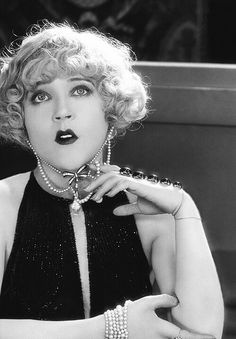Mae Murray (Marie Adrienne Koenig)

Mae Murray first began acting on the Broadway stage in 1906 with dancer Vernon Castle. In 1908, she joined the chorus line of the Ziegfeld Follies, moving up to headliner by 1915. Murray became a star of the club circuit in both the United States and Europe, performing with Clifton Webb, Rudolph Valentino, and John Gilbert as some of her many dance partners. Mae Murray made her motion picture debut in To Have and to Hold in 1916. She became a major star for Universal, starring with Rudolph Valentino in The Delicious Little Devil and Big Little Person in 1919. At the height of her popularity, Murray formed her own production company with her director, John M. Stahl. Critics were sometimes less than thrilled with her over-the-top costumes and exaggerated emoting, but her films were popular with movie-going audiences and financially successful. In 1925, Murray, Leonard, and Stahl produced films at Tiffany Pictures, with Souls for Sables (1925), starring Claire Windsor and Eugene O’Brien, as the first film made by Tiffany. For a brief period of time, Murray wrote a weekly column for newspaper scion William Randolph Hearst. At her career peak in the early 1920s, Murray, along with such other notable Hollywood personalities as Cecil B. DeMille, Douglas Fairbanks, William S. Hart, Jesse L. Lasky, Harold Lloyd, Hal Roach, Donald Crisp, Conrad Nagel and Irving Thalberg was a member of the board of trustees at the Motion Picture & Television Fund – A charitable organization that offers assistance and care to those in the motion picture and television industries without resources. Four decades later, Murray herself received aid from that organization.
In the early 1920s, Mae Murray was painted by the well known Hollywood portrait painter Theodore Lukits. This work titled Symphony in Jade and Gold (The Actress Mae Murray) (1922, Private Collection, Northern California) depicted Murray in the nude, gazing in a mirror. It was exhibited at the Pacific Asia Museum in 1999 and two other venues as part of the exhibition Theodore Lukits, An American Orientalist. Murray appeared in the title role in the Erich von Stroheim directed film The Merry Widow (1925), opposite John Gilbert. When silent films gave way to talkies, Murray made an insecure debut in the new medium in Peacock Alley (1930), a remake of her earlier 1921 version Peacock Alley. In 1931, she was cast with newcomer Irene Dunne, leading man Lowell Sherman, and with fellow silent screen star Norman Kerry in the talkie Bachelor Apartment. The film was critically panned at the time of release and Murray made only one more film, High Stakes (1931) also with Sherman. A crucial blow to her film career occurred after she married her fourth husband, David Mdivani, a Georgian man of minor aristocratic roots, whose brothers Serge and Alexis married actress Pola Negri and the heiress Barbara Hutton respectively. The couple married on June 27, 1926, and Mdivani became her manager, suggesting that his new wife ought to leave MGM. Murray took her husband’s advice and walked out of her contract with MGM, making a powerful foe of studio boss Louis B. Mayer. Later, she would swallow her pride and pleaded to return, but Mayer would not rehire her. In effect, Mayer’s hostility meant that Murray was blacklisted from working for the Hollywood studios. Meanwhile, in 1927, Murray was sued by her then-masseuse, the famous Hollywood fitness guru Sylvia of Hollywood for the outstanding amount of $2,125 during a humiliating and detailed court case.
In the 1940s, Mae Murray appeared regularly at Billy Rose’s Diamond Horseshoe, a nightclub which specialized in a “Gay ’90s” atmosphere, often presenting stars of the past for nostalgic value. Her appearances collected mixed reviews: her dancing (in particular the Merry Widow Waltz) was well received, but Murray refused to acknowledge her age, wearing heavy layers of makeup and fitting her mature figure into short skirted costumes with plunging necklines. In 1946, she taught ballroom dancing to young teenagers at a dance studio in Los Angeles. It was located on Crenshaw Blvd. near 48th St. Murray’s finances continued to collapse, and for most of her later life she lived in poverty. She was the subject of an authorized biography, The Self-Enchanted (1959), written by Jane Ardmore, that has often been incorrectly called Murray’s autobiography. In February 1964, Murray was found disoriented in St. Louis, thinking that she had completed a bus trip to New York. Murray explained to a Salvation Army officer that she had become lost trying to find her hotel, which she had forgotten the name of. She also refused bus fare back to Los Angeles as she claimed to have a ticket for the remainder of the journey in her purse, “if she could find it.” Many years later, Mae Murray moved into the Motion Picture House in Woodland Hills, a retirement community for Hollywood professionals. She died there on March 23, 1965 at the age 79. She is interred in Valhalla Memorial Park Cemetery, North Hollywood, California.
Born
- May, 10, 1885
- USA
- New York, New York
Died
- March, 23, 1965
- USA
- Woodland Hills, Los Angeles, California
Cemetery
- Pierce Brothers Valhalla Memorial Park
- North Hollywood, California
- USA



